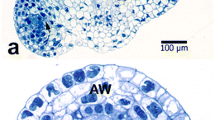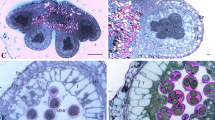Summary
The ultrastructure of the vegetative cell ofBrassica napus tricellular pollen grains, just before anthesis with standard chemical fixation, is reported. The vegetative cell may be regarded as a highly differentiated and metabolically active fat-storage cell. It contains many mitochondria with a well developed internal membrane system, starchless plastids, microbodies, lipid bodies, dictyosomes and numerous vesicles thought to originate from the dictysomes. Rough endoplasmic reticulum organized in stacks of cisternae is also spatially associated with certain organelles, mainly lipid bodies, microbodies and plastids. There are also randomly distributed polyribosome areas. The microbodies are mainly polymorphic in shape and are often observed in contact with lipid bodies. The above spatial relationship implies that the microbodies may have a glyoxysomal function. In the late period of vegetative cell maturation, the microbodies are probably involved in the process of glyconeogenesis in which the conversion of lipid reserves to sugar takes place.
Similar content being viewed by others
Abbreviations
- VC:
-
vegetative cell
- VN:
-
vegetative nucleus
- SC:
-
sperm cell
- M:
-
mitochondria
- MB:
-
microbodies
- L:
-
lipid body
- P:
-
plastid
- D:
-
dictyosomes
References
Baker HG, Baker I (1979) Starch in angiosperm pollen grains and its evolutionary significance. Am J Bot 66: 591–600
Beevers H (1980) The role of the glyoxylate cycle. In: Stumpf PK (ed) In the biochemistry of plants, vol. 4. Academic Press, New York, pp 117–129
Bregfeld R, Schopfer P (1984) Transitory development of rough endoplasmic reticulum aggregates during embryo maturation in seeds of mustardSinapis alba L. Eur J Cell Biol 34: 27–33
Charzynska M (1984) Various pathways of sister cell differentiation vegetative and generative in the pollen grain ofTradescantia. Post Biol Kern 2: 589–592
—, Murgia M, Milanesi C, Cresti M (1989) Origin of sperm cell association in the “male germ unit” ofBrassica pollen. Protoplasma 149: 1–4
Ciampolini F, Moscatelli A, Cresti M (1988) Ultrastructural features ofAloe ciliaris pollen. I. Mature grain and its activation in vitro. Sex Plant Reprod 1: 88–96
Clarke E, Steer MW (1983) Cytoplasmic structure of germinated and ungerminated pollen grains ofTradescantia virginiana. Caryologia 36: 299–305
Cresti M, Keijzer CJ (1985) The structure of the endoplasmic reticulum in pollen grains and pollen tubes, after osmium tetroxidepotassium ferricyanide stainingNicotiana alata. J Submicrosc Cytol 17: 615–620
—, Ciampolini F, Mulcahy DLM, Mulchay G (1985) Ultrastructure ofNicotiana alata pollen, its germination and early tube formation. Am J Bot 72: 719–727
—, Pacini E, Ciampolini F, Sarfatti G (1977) Germination and early tube development in vitro ofLyopersicum peruvianum pollen: ultrastructural features. Planta 136: 239–247
Dickinson HG, Elleman CJ (1985) Structural changes in the pollen grain ofBrassica oleracea during dehydration in the anther and development on the stigma as revealed by anhydrous fixation techniques. Micron Microsc Acta 16: 255–270
Dumas C, Knox RB, Gaude T (1985) The spatial association of the sperm cells and vegetative nucleus in the pollen grain ofBrassica. Protoplasma 124: 168–174
Gurr MI (1980) The biosynthesis of triacylglycerols. In: Stumpf PK (ed) The biochemistry of plants, vol. 4. Academic Press, New York, pp 205–248
Heslop-Harrison J (1987) Pollen germination and pollen-tube growth. Int Rev Cytol 107: 1–78
Hoekstra FA (1979) Mitochondrial development and activity of binucleate and trinucleate pollen during germination in vitro. Planta 145: 25–36
—, Bruinsma J (1979) Protein synthsis in binucleate and trinucleate pollen and its relationship to tube emergence and growth. Planta 146: 559–566
Kindl H (1982) The biosynthesis of microbodies (peroxisomes, glyoxysomes). Int Rev Cytol 80: 193–229
Lazarow PB, Fujiki I (1985) Biogenesis of peroxisomes. Ann Rev Cell Biol 1: 489–530
Lin IH, Huang AHC (1983) Lipase in lipid bodies of cotyledons of rape and mustard seedling. Arch Biochem Biophys 225: 360–369
—, Wimer LT, Huang AHC (1983) Lipase in the lipid bodies of corn scutella during seedlings growth. Plant Physiol 73: 460–463
McConchie CA, Jobson S, Knox RB (1985) Computer-assisted reconstruction of the male germ unit in pollen ofBrassica campestris. Protoplasma 127: 57–63
—, Russell SD, Dumas C, Touhy M, Knox RB (1987) Quantitative cytology of the sperm cells ofBrassica campestris andBrassica oleracea. Planta 170: 446–452
Mollenhauer HH, Morré DJ, Kelley AG (1966) The widespread occurrence of plant cytosomes resembling animal microbodies. Protoplasma 62: 44–52
Pais MS, Feijo J (1986) Microbodies proliferation and lipid catabolism in pollen grains. Maturation ofOphrys lutea. Eur J Cell Biol 41: 32
— — (1987) Microbody proliferation during the microsporogenesis ofOphrys lutea Cav (Orchidaceae). Protoplasma 138: 149–155
Reiss HD, Herth W (1979) Calcium ionophore A 23187 effects localized wall secretion in the tip of pollen tubes ofLilium longiflorum. Planta 145: 225–232
Sangwan RS, Sangwan-Norreel BS (1985) Early indicators of in vitro tranformation from gametophyte to sporophyte inDatura. In: Willemse MTM, van Went JL (eds) Sexual reproduction in seed plants ferns and mosses. Pudoc, Wageningen, pp 76–78
Schopfer P, Bajracharya D, Bergfeld R, Falk H (1976) Phytochromediated transformation of glyoxysomes into peroxisomes in the cotyledons of mustardSinapis alba L. seedlings. Planta 133: 73–80
Tolbert NE (1980) Microbodies-peroxisomes and glyoxysomes. In: Tolbert NE (ed) The biochemistry of plants, vol 1. Academic Press, New York, pp 359–388
Tolbert NE, Essner E (1981) Microbodies: peroxisomes and glyoxysomes. J Cell Biol 91: 271s-283s
Trelease RN (1984) Biogenesis of glyoxysomes. Ann Rev Plant Physiol 35: 321–347
Wiskich JT (1980) Control of the Krebs cycle. In: Stumpf IK (ed) The biochemistry of plants, vol 2. Academic Press, London, New York, pp 271–273
Wiskich JT, Dry IB (1985) The tricarboxylic acid cycle in plant mitochondria: its operation and regulation. In: Douce R, Day DA (eds) Higher plant cell respiration. Springer, Berlin Heidelberg New York Tokyo, pp 297–330 [Pirson A, Zimmermann MH (eds) Encyclopedia of plant physiology, vol 18]
Author information
Authors and Affiliations
Rights and permissions
About this article
Cite this article
Charzynska, M., Murgia, M. & Cresti, M. Ultrastructure of the vegetative cell ofBrassica napus pollen with particular reference to microbodies. Protoplasma 152, 22–28 (1989). https://doi.org/10.1007/BF01354236
Received:
Accepted:
Issue Date:
DOI: https://doi.org/10.1007/BF01354236




